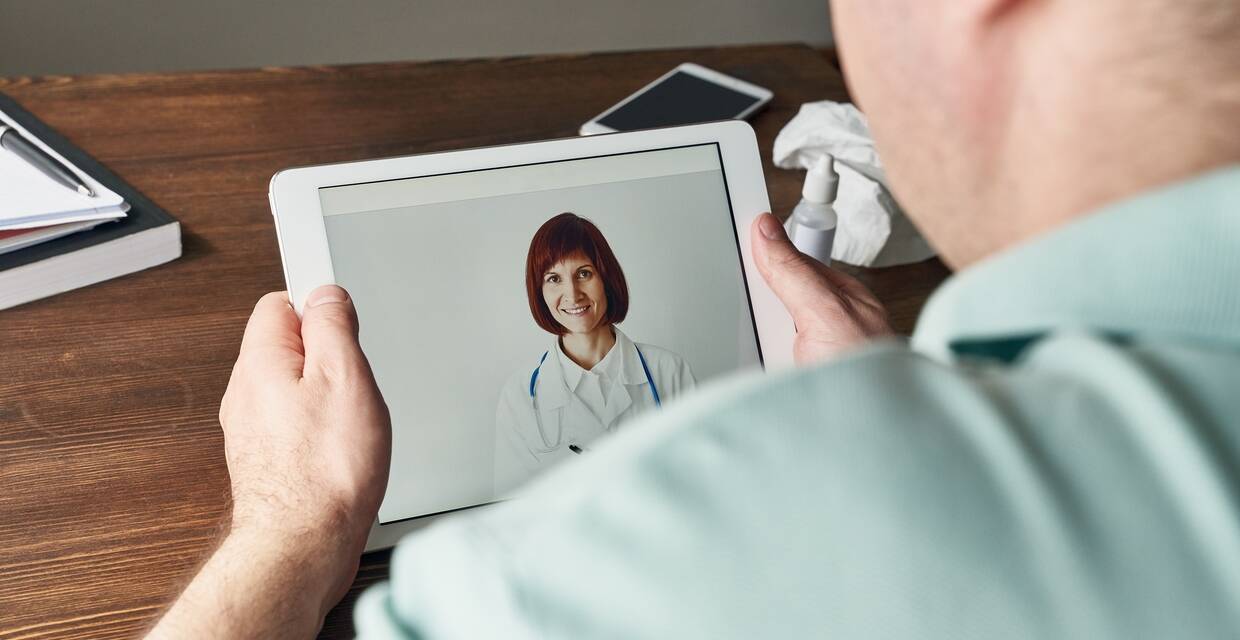Telehealth services have been around since the early 2000s, but faced low patient adoption and significant restrictions imposed by Centers for Medicare & Medicaid Services (CMS) and private insurers prior to the COVID-19 pandemic.
CMS permanently expanded some telehealth service reimbursement in December 2020—a move that proved favorable for patients and providers alike to maintain telehealth utilization. In an additional effort to increase long-term telehealth usage nationwide, CMS also lowered some administrative hurdles unlocking further access to telehealth.
In fact, A FAIR Health analysis showed an almost 3000% increase in telehealth claims from November 2019 to November 2020, up from 0.2% of medical claims to 6%.
Telehealth services increase patient loyalty
Patients are demanding access to telehealth from their providers. Don’t get confused by the sharp decline in telehealth visits as COVID begins to wind down.
Pre-COVID data suggest that less than 1% of ambulatory visits were telemedicine. During COVID, those cases rose to over 65% of cases in the ambulatory setting and are now leveling out at around 5-7% of total visits—or 500–700% above pre-COVID levels.
We’ve seen a 5x increase (5-8%) of patients who still want to use Video Telemed for ambulatory visits up from 1% pre-COVID (UC data), and I believe cases will stay at this level and then begin to rise as our technological infrastructure continues to improve.
Just like selecting a coffee shop to frequent because you can order in advance on an app, patients will continue to expect less friction in the process of meeting everyday health care needs. Patients are migrating to the path of least resistance.
96% of patients say they received the care that they needed through Video Telemed, and 88% of patients surveyed say that they are more likely to visit the same provider again because they offer telehealth (Solv consumer survey). Consumers start their search for care online and are presented with many options for healthcare services. Having an omnichannel strategy isn’t nice to have—it’s a requirement to succeed in the new ecosystem developing in front of us.
An end-to-end patient scheduling solution needs to present patients with the option to select a telehealth visit, in-person visit, and asynchronous chat with the clinic. This also helps your staff seamlessly transfer the treatment setting when a patient who started a virtual consultation needs to be evaluated in person. The patient can schedule a clinic appointment in 2 taps with no data re-entry to save time—and the brand provides a consistent patient experience.

Solv internal data shows that only 13% of telehealth visits were referred to Urgent Care, a specialist, or Emergency Department. That means 87% of folks received everything they needed from their telehealth visit without needing to see a provider in-person.
Expense reduction as technology will ultimately be a strong external pressure on the industry to adopt telehealth as an integral part of our system. Moore’s Law is in full effect here—as technology advances exponentially in healthcare, eventually the unit economics will become the driving force. All visits that don't require an in-person consultation will be delivered via telehealth. Mobile phone devices, in particular, will soon be the primary source of truth for all healthcare records, and lack of interoperability becomes much less of a problem when all pertinent information is searchable in one location.
Reviews from patients after their telehealth visit
- “My first virtual pediatric experience was amazing. They got the job done and helped out a lot. Filled my son's prescription, viewed him and the issue. Saved a trip to urgent care. HIGHLY RECOMMEND“
- “It is raining bad and this helped not make a 45 min trip in the rain with a cranky 4-year-old. I recommend this!!! She could look at him and hear his cough to know he was sick.”
- “We had a virtual session. My wait time was under 5 minutes, and I didn't need to change out of our PJs. The doctor was friendly and patient, and she gave us options instead of just ordering antibiotics. I highly recommend!”
Regulatory and reimbursement have become more favorable
The pandemic required payers to temporarily remove barriers to telehealth service reimbursement to allow telemedicine to be practiced across state lines, both from patient homes as well as clinical settings. Payment laws were modified to improve parity with in-person payment. Fortunately, many of these laws have been made permanent. With the lobbying efforts of the insurance industry, and more legislation that opens up access will likely be written or adopted as permanent.
Improved overall access for wellness services
As providers, payers, and health systems begin to triangulate on how to deliver high quality (with more focus on wellness) and lower the total cost of care, telemedicine will no doubt be at the table. Telehealth brings enhanced, sustainable changes to reimbursement for services that get woven into the fabric of our new healthcare system. Retrospective studies have already begun to gather learnings from the height of the pandemic and apply those via regulatory and policy changes.
I have come across some independent practitioners who do not want to offer their own telehealth solution, but instead, have chosen to partner with someone outside of their existing market to provide a telehealth solution. That is not ideal. As a former healthcare operator, I would not want to outsource a vital piece of my business for two fundamental reasons. First, I don't want to lose out on revenue from a service line that I can easily support with my existing workforce and software. But even more importantly, healthcare is—and always will be—a service that is best delivered by folks within that community. It's critical for proper referral management (in-network requirements) and patient engagement.
Did you know?
- In some areas of outpatient medicine, telehealth visits comprise the majority of visits to the practice. There are even virtual hospitals like Mercy Virtual, which prove that telehealth is a primary means to care for acutely ill patients at home
- Median telehealth visits on Solv last about 12 minutes, much less time than the national average door-to-door time of 70 minutes in an in-person urgent care visit. Providing telehealth visits is faster, with a higher return on investment and provider time while still giving the patient high-quality care and addressing their questions without having to drive anywhere, deal with traffic, navigate a parking lot, or experience a wait time
Have the ability to specifically target at-risk populations
As data continue to emerge showing deepening of the racial and socio-economical divide in our country and its impact on health, there will be increased pressure on payers, providers, and health systems to level the playing field. Better access to broadband internet connections and other determinants of health will need to be addressed. At that point, layering in telemedicine as a primary source of care can easily begin to change the health status of this population.
Increase patient throughput, improve engagement, and drive more revenue for your practice
A benefit of providing online appointments is visibility into who your patients are, why they’re coming to see you, and when they’d like to be seen. Use telehealth to load-balance your walk-in patients to better distribute the day's workload. You can reduce overall wait times and improve staff efficiencies. A more efficient process for both patients and staff will result in a better experience, higher satisfaction (and therefore engagement), and ultimately, more visits and revenue.
As Americans become more comfortable venturing out for in-person services, we’re seeing a higher number of walk-in patients seeking care. Often, walk-in patients come during the same busy times (before 9:00 am, 12:00 pm, and after 4:00 pm) which can cause long wait times. Oftentimes, patients who walk in for care have a low acuity visit that can be treated successfully through a telehealth visit by a provider at another site (or at home!).
A Solv patient survey found that 67% of patients would leave your practice if you did not offer a virtual care option. It seems that there is inherent perceived value in having a telehealth option available at your doctor's office. Offering telemedicine doesn’t mean that your patients will never come in person again, but it does make it easier for your patients to access high-quality care in a more convenient way. It locks them into your practice with the extra peace of mind it offers and shortens their overall wait time.
Telehealhwill cost you more by not offering it to patients who have come to expect and appreciate a different way to receive care.




